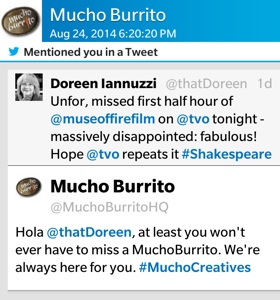I have nothing against burritos, but at the risk of calling out a brand on their Twitter usage this didn’t work…for me.
Did it work for the brand in question? Perhaps, depending on their strategy – eg., we will engage/reply with designated hashtag “x” times per day (“though this be madness, yet there is method in’t”…) Yes, that’s admittedly a stretch, and a flawed one at that, but it’s the only one that comes to mind.
Could it have worked for me? Possibly. If…
– I was a foodie blogger with a love for all things burrito…and,
– the reply was in the form of iambic pentameter, character count limitation aside…and,
– I had previously interacted with the brand in question, or at least made it known I was a fan.
When does it work? Well, this one kind of did.
In this case, I had previously tweeted about Keifer Sutherland’s “24” and used their hashtag. Was their tweet to me meaningful? Did they retweet my reply back to them? Yes and no, but at least I noticed they were paying attention and aware that I was a fan, even though they were pushing out the same question to a bunch of their followers.
It’s been said before, but if you’re a brand on Twitter and want to engage with who you follow, make it meaningful. Know thy audience. (“This above all: to thine own self be true”)
And, finally, for the love of Hamlet!, make your hashtags relevant – I can’t tell if #MuchoCreatives is a creative ad agency marketing burritos, a restaurant, or a burrito brand. Sure, in the final analysis you will rack up the number of hashtag mentions, but it will largely be a meaningless number.
(Dear MuchoCreativeHQ: consider that last hashtag mention on the house.)


You nailed it, Doreen.
I think so many brands have gotten past the early flush of so-me excitement (which is a very good thing), and have moved on to the stage where they’re trying to find the right weight to give it in the suite of marketing tactics.
Unfortunately, in this stage, tactics get relegated to less experienced practitioners, and ham-handed executions like the one you shared (and it’s just one of a legion of similar examples from a variety of brands) become far too common. Senior staff spend more time looking at raw results data than daily implementation.
Hopefully brands learn when folks like you share these examples and processes get reviewed as a result. It’s just like the lessons we learned when we first started building Web sites and blogs, and like our colleagues experienced in the days when other media were emerging.
‘Twas ever thus….. 😉
Yes, thanks Jennifer. Great insight. For sure: achieving a quantifiable objective (which is my assumption in this case) when it’s at the exclusion of all else, such as the daily implementation you noted. BTW, I chose deliberately to not hyperlink to the brand in question (either in the post above or in the tweet I sent out a couple of hours ago), as I’m curious to see the extent of their monitoring…